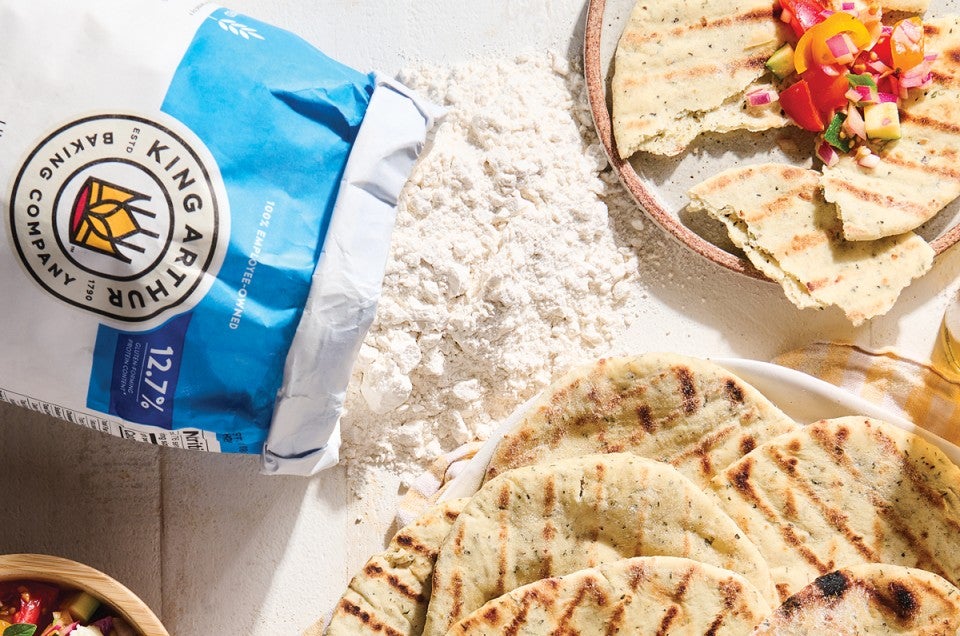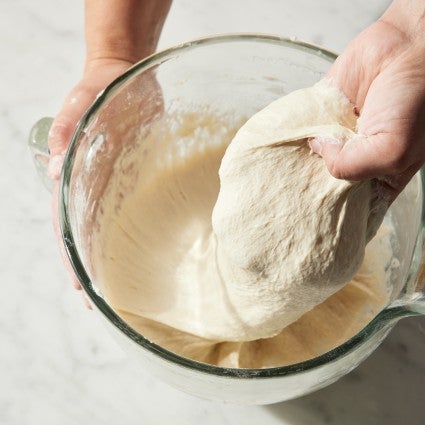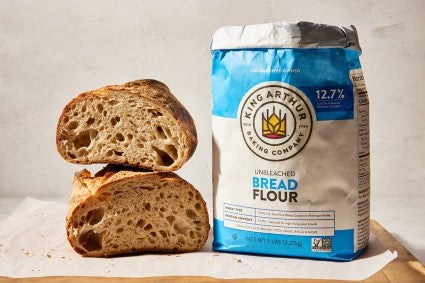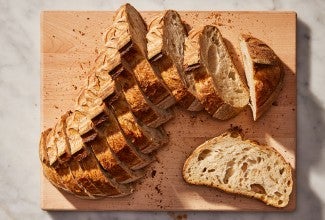


Have you ever wondered about the difference between all-purpose flour and bread flour? Or maybe you’ve noticed the big number on the front of King Arthur flour bags (11.7%, in the case of all-purpose flour) and been curious about what, exactly, it refers to. The answer to both questions is the same: protein percentage, one of the most important variables in flour. But what exactly does that mean, and why does it matter?
Please note: The protein percentages listed for certain types of flour in this post are what we here at King Arthur guarantee. Other brands often have a more variable protein percentage, so results may differ.
When we’re talking about protein in flour, we’re talking about two very specific types of protein found in wheat: glutenin and gliadin.
Crucially, these two proteins are the building blocks of gluten. When water (or a liquid including water, like milk) is added to these two proteins, they link together, forming gluten. Gliadin gives the dough extensibility (which means the dough can be stretched), while glutenin contributes elasticity (so it can snap back like a rubber band).
Ultimately, if the proteins in flour form gluten, then the more protein in the flour — i.e., the higher its protein content — the more gluten-forming potential that flour has. Another way to think about it: the higher the protein content, the “stronger” the flour.

Let’s cover a brief summary of gluten’s role in baking. When liquid is added to glutenin and gliadin, they start forming bonds that link together, developing strands of gluten.
As you mix and knead batters and doughs, you encourage the gluten to develop further. That’s because this movement and agitation encourages the gluten strands to link up and form a network, making them even stronger.
This glutinous web is capable of trapping gas bubbles; the stronger it is, the more gas it can hold, leading to more air in a baked good and thus a higher rise. At the same time, those interconnected strands become longer and stronger the more the gluten develops, which leads to more chewiness and toughness in the final product.
This can be good: You want a strong gluten network in bread dough to capture the gases produced during fermentation. It can also be bad: You don’t want a chewy, stretchy gluten network when making a soft, tender cake.
That’s why the amount of gluten-forming potential in your flour, and thus its protein percentage, matters.
Let’s review three primary types of flour and how their protein content corresponds to their intended use for baking.
Cake flour: With a protein percentage of 10%, this is considered a low-protein flour. It has less gluten-forming potential; when you mix batter made with cake flour rather than all-purpose, less protein is present, and as a result, the batter will likely develop less gluten, resulting in more tender baked goods.
Bread flour: With a protein percentage of 12.7%, this is considered a high-protein flour. It has more gluten-forming potential; when you mix dough made with bread flour rather than all-purpose, more protein is present, and as a result, the dough will likely develop more gluten.
All-purpose flour: With a protein percentage of 11.7%, this flour sits comfortably in the middle — enough protein to develop gluten in bread dough, but not so much that it can’t also be used to make tender cakes, scones, biscuits, and more.
There are plenty of other flours, all with different protein percentages suited to specific types of baking. There’s high-gluten flour, for instance, with a whopping 14.2% protein content that makes it well suited to artisan breads or bagels; on the opposite end of the spectrum, pastry flour has only 8% protein content, so it’s great for bakes like biscuits, scones, and pie crusts.

And finally, a note on whole wheat flours. The total protein content of whole wheat flour is 13.2%, so you might think that, because of its high protein percentage, it would automatically be great for making bread. And it is, but with some caveats.
Because whole wheat flour contains all parts of the wheat berry, including the bran and the germ, the gluten structure is affected. That’s because bran has sharp edges when ground, which cut some of the gluten strands and interferes with their structure. So bread recipes (and other baked goods) with whole wheat flour typically call for specific steps to get around this: They’ll include a long rest time to allow the wheat bran to soften, or call for a second type of flour to get the flavor and nutrition of whole wheat flour but the gluten benefits of another flour.

Unfortunately, some flour brands allow wide fluctuations in their protein content, so every time you use a new bag of flour, you’ll get slightly different results. King Arthur flour, however, is milled with the strictest specifications in the industry. We guarantee that the protein percentage that’s printed on the front of the bag will always match the flour inside of it.
Baking with flour that has a uniform protein content will give you the best, most consistent results at home, so there’s no wasted time or ingredients — just lots of delicious baked goods.
Cover photo by Danielle Sykes; food styling by Liz Neily.


